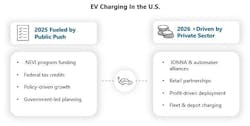EVs in America 2025: Record Sales, Policy Pivots, and the Private-Sector Push
Key Highlights
- U.S. EV sales reached an all-time high in 2024, despite a slowdown in growth rate and infrastructure challenges.
- Policy changes, including the revocation of federal tax credits after September 2025, are prompting a consumer rush to purchase EVs before incentives end.
- The NEVI program, initially halted and then reinstated with relaxed rules, plays a crucial role in expanding charging infrastructure, though uneven deployment remains a concern.
- Private sector investment is the backbone of U.S. charging growth, with partnerships, retail collaborations, and entrepreneurial efforts outpacing public programs.
- Winning in the U.S. market now depends on strategic alliances, reliable charging infrastructure, and diversification into commercial and heavy-duty EV segments.
For much of 2024, the mood around Electric Vehicles (EVs) in the United States was marked with doubt. Headlines about a “slowdown” painted a picture of weakening momentum.
But very often, perception outweighs reality. This was the case with North America as well. The market never slowed down; in fact, in 2024, EV sales in the U.S. reached a record high, the most in its history. What slowed was never adoption or the sales, but the year-on-year growth rate of EVs.
Meaning the expansion in the 2023–24 period was more measured as compared to the booming jump experienced by the U.S. EV market in the 2022–23 period. To put things into perspective, Europe experienced a decline in actual EV sales last year. It was a 1% dip. In contrast, North America saw record EV sales, but the pace of growth slowed compared to the previous year.
The Anatomy of Slow Growth
The framework of this slow growth rate was primarily defined by the reliability of the charging infrastructure, further fueled by policy reversals by the Trump government. Here are some of the main problems that undermined consumer confidence,
- Charger Reliability Issues: Many public chargers were broken, slow, or offline.
- Inconsistent Coverage: Rural areas and smaller towns were underserved.
- Fragmented Network Experience: Meaning a lack of interoperability, different charging networks, different apps, and different pricing structures.
- Policy Volatility: The change in administration brought uncertainty, especially when the Nevi program was paused.
It all makes sense, because why would the customer want to switch to an electric vehicle when it cannot count on chargers? And if these problems were still intact, then how were EV sales in the U.S. recorded to be an all-time high in its history in 2024?
Let us break this down step by step in the discussion that follows.
2025 Reality Check: Incentives Pulled, Consumers Rushing In
The Biden government had placed a federal tax credit of up to $7,500 for new qualified EVs and a $4,000 credit for used ones. The existing government has revoked these credits for cars purchased after Sept. 30, 2025. Meaning after that date, buyers will no longer be eligible for the credits if they buy new or used EVs.
Predictably, this will create a rush effect. The first quarter of 2025 was subdued, Q2 was a little better, and the ongoing Q3 is expected to be much stronger as consumers race to take advantage before the benefit disappears.
The NEVI Program Saga
No discussion of U.S. charging infrastructure is complete without the National Electric Vehicle Infrastructure (NEVI) Program. It was launched in 2022 as a part of a $5 billion federal push to expand EV charging infrastructure. It mandated installations roughly every 50 miles across highways. For many Charge Point Operators (CPOs) and OEMs, it became the anchor of their expansion plans.
Then came 2024. With the change in administration, the program was abruptly halted, leaving ongoing projects stranded and investor confidence rattled. The disruption was real because the companies that had bet on NEVI contracts were forced to slow down or shelve plans.
Then the good news arrived in 2025. The program was reinstated, and this time with looser conditions. Gone is the,
- Rigid 50-mile spacing rule. CPOs now have greater flexibility to install chargers where they see actual demand.
- Plan approval & documentation. The new guidance streamlines state plan submissions.
- Site location strictness. There is more flexibility in selecting the host site of the chargers.
This shift in these rules and others brings up sides and downsides. On the positive side, projects can be rolled out faster and more profitably. On the negative, rural and underserved regions risk being left behind, as investors cluster chargers in dense, high-utilization areas.
Private Sector at the Wheel
It is worth stressing that the NEVI program is only one piece of the puzzle, and not even the largest one. The real backbone of U.S. charging growth is private-sector investment.
In the U.S., the charging infrastructure is less centralized and more entrepreneurial. It is tightly tied to business models that demand profitability and scale.
For example,
- IONNA is a consortium of multiple automakers pooling resources to build charging networks.
- The role of major retailers like Walmart and Starbucks, which increasingly see charging stations to attract customers and extend dwell time.
- The independent players like BTC Power and Alpitronic, alongside smaller entrepreneurs installing chargers at fleet depots, commercial hubs, and urban centers.
In many ways, the private sector is outpacing the public program. But if this were the case, then why did some private players have to wrap up their U.S. operations?
But incumbents like Tesla, with its supercharger network, and local manufacturers such as BTC Power and ChargePoint already had entrenched positions. For newcomers, especially those without partnerships or scale, carving out space proved challenging.
When incentives tightened and the NEVI program paused under the new administration, the weakest players had little buffer. Ultimately, several folded operations or withdrew from the U.S. altogether.
The New Playbook: How to Win in North America
The lesson is clear: the U.S. charging market is not a speculative land grab anymore. Winning requires deep alliances, high reliability, and an ability to operate profitably without leaning on subsidies. Here are the three strategic levers that can help a charging OEM stand out,
1. Strategic Alliances
Partnerships with retailers like Walmart and Starbucks, or automaker-backed networks like IONNA, provide the scale and national footprint that no single company can achieve alone.
2. Quality Over Quantity
Reliability has become the top factor for winning consumer trust and securing large projects. Operators that deliver durable, interoperable, and easy-to-maintain chargers consistently secure the most significant contracts.
3. Diversification
The next wave of growth goes beyond passenger EVs. Heavy-duty trucks, commercial fleets, and megawatt charging for long-haul vehicles are emerging as parallel growth engines.
Suppliers that invest early in the abovementioned areas can secure market leadership as fleet electrification accelerates.
Outlook: Short-Term Rush, Long-Term Resilience
As 2025 plays out, the dynamics of North America’s EV market will be shaped by a mix of urgency and transition. The repeal of incentives will drive a temporary surge in sales before tapering off. The NEVI program’s reboot will accelerate deployments, but its loosened rules may deepen geographic imbalances.
More importantly, the private sector is stepping firmly into the driver’s seat. Retail partnerships, consortium-backed networks, and fleet charging investments are setting the stage for growth well beyond 2025.
The risks are real, the uneven access, affordability pressures, and policy unpredictability are holding the ground, but the momentum is equally strong. If 2024 was about uncertainty, 2025 is proving that the U.S. EV market is not slowing down. It is simply shifting gears.
About the Author
Hassan Zaheer
Hassan Zaheer, Managing Partner & Chief Operating Officer - PTR Inc.
Hassan is the Managing Partner & COO at PTR Inc. based in Abu Dhabi, UAE. With more than a decade of experience in the energy transition space, Hassan advises various Fortune-500 and blue-chip clients in the electrical infrastructure sector to sustainably grow their businesses, both through custom consulting work, marketing support services and tailored research reports by PTR, helping their executive management and boards make data driven decisions. Hassan is also a Member of Advisory Board for CWIEME Berlin and MENA EV Show, part of the Executive Editorial Board of APC Media and an advisor to the educational non-profit Better Humans Academy. Hassan has a tech background with a Masters in Power Engineering from the Technical University of Munich (TUM) and a BS in Electrical Engineering from the Lahore University of Management Sciences (LUMS). Additionally, he is also an Alumni of Center for Digital Technology & Management (CDTM).
Muhammad Rafey Khan
Muhammad Rafey Khan, Team Lead EVCI Service – PTR Inc.
Rafey Khan is a Senior Analyst and Team Lead for Electric Vehicle Charging Infrastructure service. His research focuses on e-mobility topics, specializing in electric vehicles and their charging infrastructure. He has worked with major EVCI systems and component manufacturers, utilities, and CPOs to conduct research and provide consulting to 30+ markets around the world. He holds comprehensive knowledge of the E-Mobility market in the USA particularly around EV and EVSE technologies, emerging market trends, and regional competitive landscape.
He is an electrical engineer from Lahore University of Management Sciences (LUMS) and holds an MBA from the Institute of Business Administration (IBA). Before joining PTR, Rafey gained valuable experience in Schneider Electric and K-Electric, which are digital automation companies and utility companies, respectively.
Najd Nasser Eddin
Najd Nasser Eddin, Client Relationship Manager
As a Client Relationship Manager at PTR, Najd is responsible for growing and strengthening PTR's client network across Europe and the Middle East. With over 5 years of experience in market expansion and client engagement, Najd has a proven track record of establishing and fostering valuable connections. Prior to joining the Power Technology and Industrial Automation sector, Najd worked for 2.5 years in the logistics industry, successfully developing markets in Europe, the Middle East, and ISC regions. With her degree in accounting and finance alongside her strong networking skills, Najd is well-equipped to contribute to PTR's success in maintaining a satisfied and strong client base.

